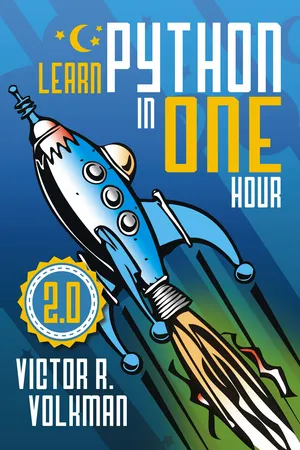
- English
- ePUB (mobile friendly)
- Available on iOS & Android
About this book
You're already a smart person, you don't need a 1000+ page book to get you started on the web's fastest growing programming platform. Instead, Learn Python in One Hour delivers on the promise of code literacy while saving your most precious commodity - time itself. Volkman's innovative programming-by-example approach means you focus on usage, not mindless detail. Based on the author's sold-out live seminars, you'll see Python's flexible coding technique in action as we refactor from script to procedural to object-oriented during actual problem solving.
In a twelve-lesson progression, you'll be exposed to this and more:
- Basic file input and output operations, incuding exceptions
- Using functions to compute and return multiple values
- Basic elements of a class definition and how to call methods
- Lists, dictionaries, sets, and other collections
- Iteration through collections, files, sorted sets
- Searching strings with regular expressions (regex)
- Client and server programs for REST methods
- Using threads in Python for multiple tasks
- CGI-BIN programming for simple HTML Forms processing
- Six most common Python pitfalls
Take the One Hour challenge and see if you too can pick up 90% of syntax and semantics in less time than you probably spend commuting each day.
About the Author Victor R. Volkman graduated cum laude from Michigan Technological University with a BS in Computer Science in 1986. Since then, he has written for numerous publications, including The C Gazette, C++ Users Journal, Windows Developers Journal, and many others. He has taught college-level programming courses at Washtenaw Community College and has served on its Computer Information Science (CIS) Faculty Advisory Board for more than a decade. Volkman says Python helped him "rediscover the joy of programming again."
From Modern Software Press
Frequently asked questions
- Essential is ideal for learners and professionals who enjoy exploring a wide range of subjects. Access the Essential Library with 800,000+ trusted titles and best-sellers across business, personal growth, and the humanities. Includes unlimited reading time and Standard Read Aloud voice.
- Complete: Perfect for advanced learners and researchers needing full, unrestricted access. Unlock 1.4M+ books across hundreds of subjects, including academic and specialized titles. The Complete Plan also includes advanced features like Premium Read Aloud and Research Assistant.
Please note we cannot support devices running on iOS 13 and Android 7 or earlier. Learn more about using the app.
Information
Table of contents
- Cover Page
- Title Page
- Copyright
- Contents
- Why Python?
- Why One Hour?
- Where to Get Python?
- Lessons Overview and Goals:
- Preface to the 2nd Edition
- Lesson One – Opening Arguments
- Lesson Two – Using Your Words
- Lesson Three – When Things Go Wrong
- Lesson Four – What’s the Frequency, Kenneth?
- Lesson Five – Fun with Functions
- Lesson Six – A Dictionary of Lists
- Lesson Seven – A Touch of Class
- Lesson Eight – Keeping it Regular
- Lesson Nine – Taking a REST
- Lesson Ten - Untangling Threads
- Lesson Eleven - Spin a Web
- Lesson Twelve - No REST for the wicked
- Python Pitfalls
- Where Do We Go From Here?
- Recommended Resources
- About the Author